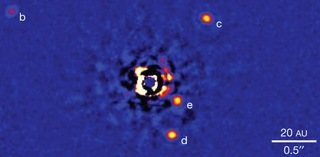
Issue 16 - April 2016
Direct imaging of exoplanets: new studies clear a path to 2020 Decadal Survey
By Bertrand Mennesson and Aki Roberge
Two mission studies of large space borne telescopes are now underway in anticipation of NASA’s 2020 Astronomy and Astrophysics Decadal Survey. NASA has announced the membership for the flagship mission Science and Technology Definition Teams (STDTs). You can find the membership for the HabEx study here: https://exep.jpl.nasa.gov/files/exep/HabExSTDT.pdf and for the LUVOIR study here: http://cor.gsfc.nasa.gov/studies/luvoir.php. Updates on the studies will be posted here: http://exep.jpl.nasa.gov/dstdt/.
The Habitable Exoplanet Imaging Mission Study, or HabEx, posits an L2 or Earth-trailing telescope with an aperture in the range of 2.4 to ~8 meters and a wavelength range covering at least the optical, and possibly extending into the near infrared and ultraviolet. It was one of four large missions recommended by three NASA Program Assessment Groups (PAGs). It also was endorsed by the NASA Advisory Council’s Astrophysics Subcommittee as worthy of NASA study in preparation for the 2020 Decadal Survey. Heading the project are HabEx study scientist Bertrand Mennesson and study manager Keith Warfield, both of JPL.
HabEx’s main science goal would be the direct imaging of Earth-sized planets in the habitable zones of other stars, using spectroscopy to look for signs of habitability and biological activity on these exoplanets. It also would seek to understand the atmospheres and surface conditions on a diverse set of exoplanets, including rocky planets, gas giants and ice giants. High contrast observations would also allow HabEx to characterize the architecture of exoplanetary systems, and study circumstellar disks at different stages of evolution. The upcoming study will also evaluate and prioritize the key non-exoplanet ancillary astrophysics programs that could be pursued with this large and uniquely stable space telescope.
The second study is for the Large UV-Optical-IR Surveyor (LUVOIR) mission. Such a general purpose, multi-wavelength observatory in the eight to 16-meter range was called for in NASA’s “Enduring Quests, Daring Visions” report. The LUVOIR study is being executed by Goddard Space Flight Center, under the leadership of a Science and Technology Definition Team drawn from the community, study scientist Aki Roberge, and study manager Julie Crooke.
Equipped with ultra-high-contrast imaging and spectroscopy capability, one of LUVOIR’s primary goals is detailed characterization of a wide range of exoplanets, including those that might be habitable – or even inhabited. The mission would also provide the tools for enormous advances in a broad range of general astrophysics, from the epoch of reionization, through galaxy formation and evolution, to star and planet formation. LUVOIR’s capabilities for advanced remote sensing of Solar System bodies will be examined in this study as well. More information on science enabled by LUVOIR may be found in “Cosmic Birth to Living Earths”, a recent report on a LUVOIR-like mission concept (the High-Definition Space Telescope) commissioned by the Association of Universities for Research in Astronomy.
Bertrand Mennesson, NASA Jet Propulsion Laboratory, Habitable Exoplanet Imaging Mission Study Scientist
Aki Roberge, NASA Goddard Space Flight Center, LUVOIR Study Scientist
